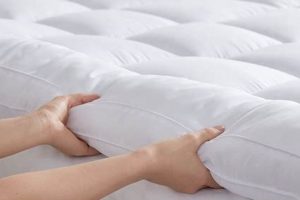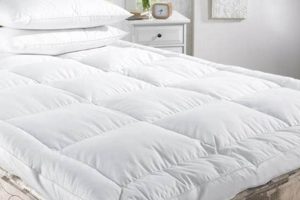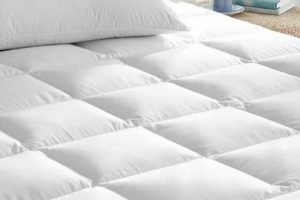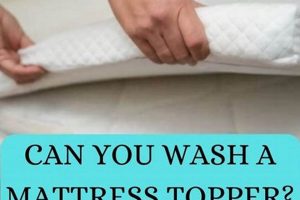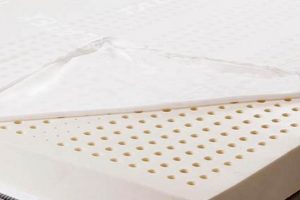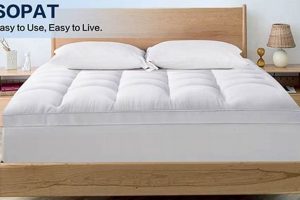A recreational vehicle queen mattress overlay enhances comfort and support on existing RV mattresses. Typically constructed from materials like memory foam, latex, or fiberfill, it adds a layer of cushioning and can alleviate pressure points. An example is a four-inch memory foam addition designed specifically to fit the dimensions of a queen-sized RV bed, improving sleep quality during travel.
These overlays are important because RV mattresses are frequently thinner and less comfortable than residential counterparts. The addition of this layer addresses this issue, contributing to better sleep, reduced back pain, and improved overall well-being while traveling. Historically, RV owners have sought solutions to improve sleeping arrangements, and these products represent a targeted approach to addressing this demand by augmenting the existing mattress.
The subsequent sections will delve into the different types of materials used in construction, factors to consider when selecting the appropriate product, and strategies for maintaining its condition over time.
Tips
The selection and care of a recreational vehicle queen mattress overlay impacts sleep quality and product longevity. The following provides guidance for optimizing both.
Tip 1: Measure the Existing Mattress Precisely: RV queen mattress dimensions vary. Precise measurement ensures the overlay provides full coverage without overhang, which compromises comfort and wear.
Tip 2: Prioritize Density Over Thickness: Higher density foam offers superior support and durability. A denser, thinner product often outperforms a thicker, low-density alternative in the long run.
Tip 3: Consider Ventilation Properties: Memory foam can trap heat. Opt for overlays incorporating gel infusions or open-cell structures to promote airflow and reduce overheating during sleep.
Tip 4: Factor in Storage Considerations: RVs often have limited storage space. Consider the overlay’s compressibility and storage requirements when not in use. Vacuum-sealable bags can reduce volume significantly.
Tip 5: Protect Against Moisture: Use a waterproof mattress protector underneath the overlay. This prevents moisture absorption from spills or condensation, mitigating mold growth and extending the lifespan of the overlay.
Tip 6: Rotate Regularly: Periodic rotation helps distribute wear evenly across the overlay surface, preventing indentations and prolonging its supportive qualities.
Tip 7: Clean According to Manufacturer Instructions: Adhere strictly to the manufacturer’s cleaning guidelines. Incorrect cleaning methods can damage the material and void the warranty.
Adherence to these guidelines optimizes the user experience and ensures a longer, more comfortable lifespan for the recreational vehicle queen mattress overlay.
The subsequent section will provide a summary of the advantages and disadvantages associated with various overlay materials, guiding a more informed purchase decision.
1. Material Composition
Material composition directly dictates the performance characteristics and longevity of a recreational vehicle queen mattress overlay. The selection of materials, such as memory foam, latex, or polyfoam, determines the overlay’s ability to provide pressure relief, regulate temperature, and resist degradation under the stresses of travel and varying climates. For example, a memory foam overlay conforms to the body, distributing weight and reducing pressure points, which is beneficial for individuals experiencing back pain. However, traditional memory foam may retain heat, leading to discomfort in warmer environments. Conversely, latex offers superior breathability and responsiveness, making it a suitable alternative for hot climates or those who prefer a firmer sleeping surface. The inherent properties of these materials, therefore, create a cause-and-effect relationship influencing the overall comfort and suitability of the overlay.
Understanding the implications of material composition is practically significant for RV owners. The confined space of an RV often exacerbates issues such as temperature fluctuations and humidity. Selecting an overlay with appropriate material characteristics can mitigate these issues. For instance, an open-cell memory foam, infused with gel particles, promotes airflow and dissipates heat more effectively than a standard closed-cell memory foam. Similarly, the density of the material impacts durability; a higher-density foam resists compression and maintains its supportive qualities for a longer duration, particularly important given the often-irregular use patterns of RVs, where the mattress may be subjected to periods of disuse followed by intense use during travel.
In summary, the material composition of a recreational vehicle queen mattress overlay is a foundational factor determining its effectiveness and durability. The choice of material influences pressure relief, temperature regulation, and resistance to wear and tear. The informed selection of materials, based on individual needs and environmental considerations, is crucial for optimizing sleep quality and ensuring the long-term value of the overlay. Ignoring this fundamental aspect can result in discomfort, premature degradation of the product, and ultimately, a diminished travel experience.
2. Thickness Options
Thickness options are a primary consideration when selecting a recreational vehicle queen mattress overlay, directly influencing comfort, support, and overall sleeping experience. The appropriate thickness must be balanced against space limitations within the RV and the user’s individual preferences.
- Pressure Relief and Support
Thicker overlays generally provide greater pressure relief and contouring, especially beneficial for individuals with joint pain or pressure sores. For example, a four-inch overlay offers more cushioning compared to a two-inch option, distributing weight more evenly. However, excessive thickness may lead to a feeling of being “swallowed” by the bed, reducing mobility.
- Space Constraints Within the RV
RVs often have limited headroom and storage space. A thicker overlay can significantly reduce available headroom and may be difficult to store when not in use. Selecting an overlay that balances comfort with practicality is essential. For instance, a three-inch overlay might provide adequate comfort while minimizing space encroachment.
- Mattress Condition Mitigation
The thickness can compensate for the condition of the existing RV mattress. A thicker overlay is more effective at masking the imperfections of an old, sagging mattress. However, it is not a permanent solution; ultimately, replacing the underlying mattress may be necessary.
- Heat Retention and Airflow
Thicker overlays, particularly those made of memory foam, tend to retain more heat than thinner alternatives. Overlays incorporating cooling technologies or open-cell structures can mitigate this issue, but the thickness still plays a role in overall temperature regulation. For example, a thinner gel-infused overlay might provide better airflow than a thicker standard memory foam option.
Therefore, the selection of an overlay thickness must consider the interplay between comfort, space, existing mattress condition, and potential temperature regulation issues. The optimal thickness provides sufficient pressure relief and support without exacerbating space limitations or heat retention problems, contributing to an improved sleep environment within the recreational vehicle.
3. Density Levels
Density levels within a recreational vehicle queen mattress overlay significantly influence its performance and durability. Measured in pounds per cubic foot (lbs/ft), density reflects the amount of material packed into a given volume. Higher density materials generally offer enhanced support, longevity, and resistance to compression, crucial factors given the constrained space and usage patterns typical of RV environments.
- Support and Pressure Relief
Higher density foams provide increased support, distributing weight more evenly and reducing pressure points. For example, a 5 lbs/ft memory foam overlay will offer superior support compared to a 3 lbs/ft counterpart, particularly beneficial for individuals with back pain or pressure sores. This is because the denser material resists compression, maintaining its shape and contouring capabilities over extended periods.
- Durability and Longevity
Density directly correlates with the lifespan of the overlay. Higher density materials withstand wear and tear more effectively, resisting sagging and indentation over time. An overlay with a density of 4 lbs/ft or higher is generally recommended for frequent use, ensuring it maintains its supportive qualities despite repeated compression and decompression. Lower density options, while initially more affordable, tend to degrade faster, necessitating more frequent replacements.
- Temperature Sensitivity
Density can influence temperature sensitivity, particularly in memory foam overlays. Higher density foams may retain more heat than lower density alternatives due to reduced airflow. However, this can be mitigated through the incorporation of open-cell structures or gel infusions, which promote ventilation and dissipate heat. The selection of a density appropriate for the user’s climate and temperature preferences is essential.
- Weight and Handling
Higher density overlays are typically heavier than lower density options, impacting ease of handling and storage. This is a relevant consideration for RV owners, who often face limited storage space and may need to frequently move or reposition the overlay. The benefits of increased support and durability must be weighed against the practical implications of increased weight and bulk.
In conclusion, density levels represent a critical factor in determining the suitability of a recreational vehicle queen mattress overlay. The optimal density balances support, durability, temperature regulation, and handling considerations. RV owners should carefully evaluate these factors to select an overlay that meets their specific needs and enhances their overall sleeping experience during travel. Ignoring density can lead to premature product failure, discomfort, and ultimately, a less enjoyable RV experience.
4. Size Conformity
Size conformity is paramount when selecting a recreational vehicle queen mattress overlay. Given the space constraints inherent in RV design and the variability in RV queen mattress dimensions, a precise fit is essential for both comfort and functionality. An improperly sized overlay can lead to discomfort, accelerated wear, and diminished effectiveness.
- Accurate Measurement
The initial step in ensuring size conformity is precise measurement of the existing RV queen mattress. Standard residential queen dimensions do not typically apply; RV queen mattresses frequently feature shortened lengths or unique corner cuts to accommodate interior layouts. Failure to account for these variations results in an ill-fitting overlay that bunches, slides, or leaves portions of the mattress exposed.
- Manufacturer Specifications
Adherence to manufacturer specifications is crucial. Reputable overlay manufacturers provide detailed dimensional data, accounting for both length and width. Reviewing these specifications before purchase prevents discrepancies between advertised and actual sizes. Discrepancies may stem from variations in manufacturing tolerances or mislabeling, necessitating careful comparison of listed dimensions with the measured mattress size.
- Edge Support Implications
Proper size conformity directly impacts edge support. An overlay that is too narrow fails to extend to the mattress edges, compromising support along the perimeter. This can lead to a sensation of rolling off the bed and accelerates wear along the uncovered mattress edges. Conversely, an oversized overlay bunches along the edges, creating an uneven sleeping surface and potentially damaging the overlay material.
- Secure Attachment Mechanisms
The presence and functionality of secure attachment mechanisms, such as elastic straps or fitted skirts, are predicated on proper size conformity. These mechanisms are designed to hold the overlay in place, preventing slippage and maintaining a smooth sleeping surface. If the overlay is improperly sized, these attachment mechanisms are rendered ineffective, leading to instability and discomfort.
In summary, size conformity is a non-negotiable factor in the selection of an RV queen mattress overlay. Accurate measurement, adherence to manufacturer specifications, consideration of edge support, and functional attachment mechanisms all depend on a precise fit. Neglecting this aspect undermines the overlay’s ability to provide optimal comfort and support, thereby diminishing the overall sleeping experience within the recreational vehicle.
5. Heat Dissipation
Heat dissipation is a critical performance characteristic of a recreational vehicle queen mattress overlay. The enclosed environment of an RV, coupled with potentially limited ventilation, often results in elevated temperatures, particularly during warmer months. Overlays constructed from materials with poor thermal conductivity exacerbate this issue, trapping heat and creating an uncomfortable sleeping environment. The primary effect is disrupted sleep, leading to fatigue and diminished well-being for RV occupants. Poor heat dissipation defeats the purpose of adding a comfort layer if it introduces thermal discomfort.
Materials significantly influence heat dissipation. Traditional memory foam, known for its conforming properties, tends to retain heat. Consequently, manufacturers incorporate design features
aimed at improving airflow. Examples include open-cell foam structures, which allow air to circulate more freely, and gel infusions, which absorb and dissipate heat. Latex overlays offer inherently better heat dissipation due to the material’s natural breathability. Fiberfill overlays, while less supportive, also tend to sleep cooler than dense foam options. Practical application of this knowledge involves selecting an overlay specifically engineered for thermal regulation, thereby mitigating heat buildup within the sleeping area.
The selection of an overlay with effective heat dissipation properties addresses a significant challenge in RV sleeping environments. Failure to prioritize this aspect can negate the intended benefits of enhanced comfort and support. Understanding the relationship between material composition, design features, and thermal performance is, therefore, essential for RV owners seeking to optimize sleep quality during their travels. The ongoing development of advanced cooling technologies within mattress overlay materials further underscores the importance of this factor within the broader context of RV comfort and livability.
6. Support Characteristics
Support characteristics are fundamental to the effectiveness of a recreational vehicle queen mattress overlay. The overlay’s ability to provide adequate support directly impacts spinal alignment, pressure distribution, and overall sleep quality. Without appropriate support, an overlay can exacerbate existing back pain or contribute to new discomfort, negating its intended purpose. This is particularly relevant in RVs where space limitations may restrict movement and prolonged periods of sitting or driving contribute to musculoskeletal strain. For example, an overlay with insufficient support will allow heavier body parts, such as the hips and shoulders, to sink too deeply into the mattress, leading to spinal misalignment and discomfort. The material density and construction play a crucial role in determining these support characteristics, influencing the overlay’s capacity to maintain a stable and level sleep surface.
The type of support offered by a recreational vehicle queen mattress overlay varies depending on its composition. Memory foam provides conforming support, molding to the body’s contours and distributing weight to alleviate pressure points. Latex offers a more resilient and responsive support, pushing back against the body and preventing excessive sinking. Innerspring overlays offer a firmer, more traditional support structure. The choice of support type should align with the individual’s sleeping preferences and any existing musculoskeletal conditions. For instance, individuals with lower back pain may benefit from the conforming support of memory foam, while those who prefer a firmer feel may find latex more suitable. The practical significance of this understanding lies in the ability to select an overlay that addresses specific support needs, thereby optimizing sleep quality and reducing the risk of discomfort.
In summary, support characteristics are an integral component of recreational vehicle queen mattress overlay performance. Adequate support ensures proper spinal alignment, pressure distribution, and overall sleep comfort. Selection of an overlay with appropriate support characteristics requires consideration of material density, construction, and individual sleeping preferences. Challenges remain in accurately assessing support needs and objectively evaluating overlay performance. Further research into optimal support characteristics for RV sleeping environments is warranted, addressing both comfort and ergonomic considerations to enhance the overall travel experience.
7. Durability Expectations
Durability expectations represent a significant factor when evaluating a recreational vehicle queen mattress overlay. The overlay is subject to unique stresses related to travel, storage, and varying environmental conditions. As such, understanding the factors influencing longevity is crucial for informed purchasing decisions.
- Material Resilience to Compression
The material’s ability to withstand repeated compression and decompression dictates its long-term performance. Higher density foams, for instance, exhibit greater resistance to sagging and indentation compared to lower density alternatives. An overlay experiencing frequent use requires a material capable of maintaining its supportive qualities despite constant pressure. RV usage patterns, characterized by periods of intense use followed by extended storage, exacerbate these stresses, necessitating materials with high compression resistance.
- Resistance to Environmental Degradation
Exposure to moisture, temperature fluctuations, and UV radiation degrades overlay materials over time. Humidity promotes mold growth, while excessive heat or sunlight causes foam to break down and lose elasticity. Overlays constructed from materials with inherent resistance to these factors, or those treated with protective coatings, offer extended lifespans in RV environments. Improper storage during off-season periods can also accelerate degradation if protective measures are not implemented.
- Seam and Construction Integrity
The quality of seams and overall construction impacts an overlay’s ability to withstand the rigors of travel. Weak seams are prone to tearing or separation, particularly under the stresses of movement and shifting weight. Reinforcement of critical stress points and durable stitching techniques contribute to the longevity of the product. Overlays subjected to frequent handling and repositioning require robust construction to prevent premature failure.
- Warranty and Brand Reputation
A manufacturer’s warranty provides an indication of their confidence in the product’s durability. Longer warranty periods typically reflect higher quality materials and construction. Brand reputation serves as a proxy for overall product reliability. Established brands with a history of producing durable mattress products are more likely to offer overlays meeting longevity expectations. However, it is important to carefully review the warranty terms and conditions to understand the specific coverage and limitations.
These factors collectively determine the lifespan and value of a recreational vehicle queen mattress overlay. RV owners prioritizing durability should carefully assess material properties, construction quality, and manufacturer reputation. Failure to consider these aspects may result in premature product failure and the need for frequent replacements, offsetting any initial cost savings.
Frequently Asked Questions
The following addresses common inquiries concerning recreational vehicle queen mattress overlays, offering objective and informative responses.
Question 1: Do RV queen mattress toppers require specialized cleaning procedures?
Cleaning protocols depend on the material composition. Memory foam typically requires spot cleaning with mild detergents, avoiding excessive moisture. Latex can tolerate gentle hand washing. Review the manufacturer’s guidelines for specific instructions to prevent damage or degradation.
Question 2: How frequently should an RV queen mattress topper be replaced?
Replacement frequency depends on material quality, usage intensit
y, and maintenance practices. High-density toppers subjected to regular use may last five to seven years. Lower-quality options or those exposed to harsh conditions may require replacement within three years. Monitor for signs of sagging, loss of support, or persistent odors.
Question 3: Can an RV queen mattress topper rectify a severely damaged RV mattress?
A topper offers enhanced comfort but cannot fully compensate for a severely damaged or structurally unsound mattress. While it may temporarily alleviate discomfort, addressing underlying mattress issues is crucial for optimal support and sleep quality. Replacement should be considered for significantly deteriorated mattresses.
Question 4: What is the ideal thickness for an RV queen mattress topper intended for back pain relief?
Thickness requirements vary depending on individual preferences and the existing mattress condition. A three- to four-inch topper typically provides adequate pressure relief and support for back pain. Consider density in conjunction with thickness; a higher density foam offers better support even at a reduced thickness.
Question 5: Do RV queen mattress toppers affect the breathability of the underlying mattress?
The impact on breathability depends on the topper material. Traditional memory foam may restrict airflow. Options incorporating open-cell structures or gel infusions enhance breathability. Latex and fiberfill toppers generally promote better air circulation compared to dense foam alternatives.
Question 6: How does weight capacity factor into selecting an RV queen mattress topper?
Weight capacity is not a primary consideration unless the combined weight of occupants exceeds the mattress’s specified limit. Focus on density and support characteristics to ensure adequate pressure distribution and prevent premature sagging, irrespective of weight capacity concerns.
Proper material selection, routine maintenance, and realistic expectations are critical for maximizing the effectiveness and longevity of an RV queen mattress topper. Addressing fundamental mattress issues is often necessary for optimal sleep quality.
The subsequent section will provide a comparative analysis of specific product offerings, highlighting key features and benefits.
Conclusion
This exploration has delineated key aspects of the recreational vehicle queen mattress overlay, encompassing material composition, thickness, density, size conformity, heat dissipation, support characteristics, and durability expectations. Optimal selection necessitates a nuanced understanding of these interconnected elements to address the unique demands of RV travel and individual user requirements.
The efficacy of any rv queen mattress topper ultimately hinges on informed decision-making and proactive maintenance. Prudent evaluation and diligent care ensure enhanced comfort and prolonged product lifespan, thereby maximizing the investment and contributing to improved travel experiences. Continued advancements in material science and design promise further enhancements to this essential component of RV outfitting.


